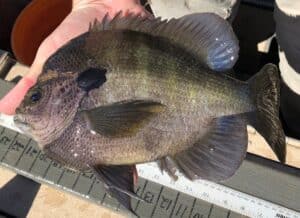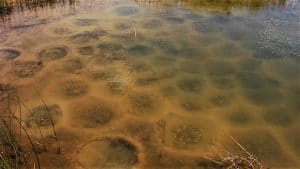
Adult Coppernose Bluegill (Male)
Bluegill are the preferred forage for supporting healthy bass populations in North Texas.
They reproduce every few weeks during the spawning season (typically late spring through early fall) and are capable of withstanding heavy predation without significantly reducing their numbers. Redear sunfish are also good forage for bass, however their reproductive potential is much lower than bluegill. It is important that management recommendations are based primarily on bass and bluegill relationships. Trends in predator/prey size distributions are good indicators of balance when trying to manage a lake for quality fishing. Pond balance is assessed by sampling both prey and predator fishes and calculating various population indices. Proportional Stock Density or “PSD” is the universally accepted index for measuring balance.
The crucial factor: having enough Bluegill to feed your bass
The crucial factor in maintaining quality fishing in a lake is to have the forage fish and largemouth bass present in optimum numbers. Ideally, there should be 5-10 lbs. of bluegill for every pound of bass in the lake. Over-harvest of either species will result in probable overpopulation of the other. For instance, if too many bass are harvested, there will be insufficient predation by the bass to control the bluegill. When this happens, the bluegill population explodes and they fiercely compete with each other for the limited food present in the lake. The resulting bluegill population can hinder successful bass reproduction by eating their eggs prior to hatch. They will also compete with newly hatched bass for available food. In this unbalanced situation, a small number of adult bass will exist, but no quality fishing for bass or bluegill will be available.

Bluegill Spawning Beds
Conversely, if too few bass are harvested, they will become overpopulated and “stunted” because the lake cannot produce adequate forage of the correct size. In this situation, the few bluegill that escape predation often grow to hand size and larger. These are too large to be effectively used as forage, and you end up with a lake full of small, stunted bass and a moderate population of very large bluegill. This is the most common scenario in small, unmanaged lakes and ponds. To avoid this situation, it is typically recommended to remove approximately 25 small bass per surface acre each year. This prevents stockpiling of small bass.
What else will Bass eat?
In the absence of bluegill, alternate forage species become very important. The most common alternate forage species are shad and tilapia. However, both species are sensitive to water temperatures and are prone to large scale die-offs during the winter. They are good for seasonal supplementation of the forage base, but they are not considered a sustainable resource for supporting large populations of quality sized bass. Shad and tilapia will require periodic re-stocking if used as supplemental forage.
For more information about stocking your pond or lake to balance predator and prey populations, read our page on Fish Stocking, and this blog post on fish stocking recommendations.
